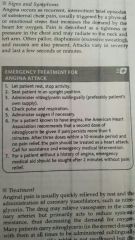![]()
![]()
![]()
Use LEFT and RIGHT arrow keys to navigate between flashcards;
Use UP and DOWN arrow keys to flip the card;
H to show hint;
A reads text to speech;
14 Cards in this Set
- Front
- Back
|
Angina signs and symptoms |
Intermittent brief episodes of substernal chest pain, usually triggered by a physical or emotional stress that increases the demand by the heart for oxygen. Tightness or pressure in the chest and may go to the neck and left arm. Excessive sweating and nausea. Lasts for few seconds to minutes |
|
|
Emergency treatment for Angina attack |

|
|
|
What is a Myocardial infarction (MI)? |
Heart Attack |
|
|
What is nitroglycerin used for and what are the different forms? |
It is used for Anginal pain (chest pain) And the forms are topical ointment, nasal spray, a skin patch or an oral tablet (isosorbide) |
|
|
How does a MI occur? |
When a coronary artery is totally obstructed leading to prolonged ischemia and cell death or infarction of the heart wall. Most common cause is atherosclerosis |
|
|
The SA node is what for the heart? |
Pacemaker for the heart and it's rate can be altered |
|
|
Bradycardia refers to what? |
Regular but slow heart rate less than 60 bpm |
|
|
Tachycardia refers to what? |
Regular rapid heart rate 100 to 160 bpm |
|
|
What is sick sinus syndrome |
A heart condition marked by alternating bradycardia and tachycardia often requires a mechanical pacemaker |
|
|
Fibrous pericardium |
Tough outer layer that attaches the heart to surrounding structures such as the diaphragm. |
|
|
The serous pericardium includes what |
Partial pericardium and visceral pericardium |
|
|
What layer is the Partial pericardium |
The inner suface of the fibrous pericardium encases the heart like a sac |
|
|
What layer is the visceral pericardium |
Reaches the great vessels, it folds under itself and forms a layer that adheres directly to the heart. |
|
|
Signs and symptoms of a heart attack (MI) |
Chest pain that's radiates to the left arm, shoulder, jaw, or neck. Described as sever, steady or crushing. Pale look, sweating , nauaea, dizziness, labored breathing, or weakness. Marked anxiety and fear. Hypotension the pulse is rapid and weak as cardiac output decreases and shock develops. Low grade fever |

